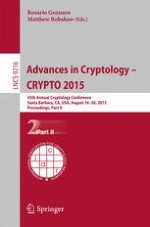The two volume-set, LNCS 9215 and LNCS 9216, constitutes the refereed proceedings of the 35th Annual International Cryptology Conference, CRYPTO 2015, held in Santa Barbara, CA, USA, in August 2015. The 74 revised full papers presented were carefully reviewed and selected from 266 submissions. The papers are organized in the following topical sections: lattice-based cryptography; cryptanalytic insights; modes and constructions; multilinear maps and IO; pseudorandomness; block cipher cryptanalysis; integrity; assumptions; hash functions and stream cipher cryptanalysis; implementations; multiparty computation; zero-knowledge; theory; signatures; non-signaling and information-theoretic crypto; attribute-based encryption; new primitives; and fully homomorphic/functional encryption.
